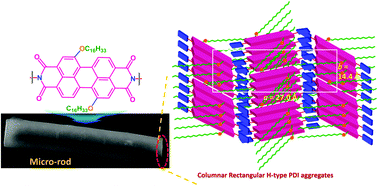Influence of imide-substituents on the H-type aggregates of perylene diimides bearing cetyloxy side-chains at bay positions†
Abstract
A series of perylene-3,4:9,10-tetracarboxylic acid diimides (PDIs, namely TYR-PDI, AEP-PDI, CET-PDI, ANP-PDI and KOD-PDI), comprising long linear cetyloxy side-chains functionalized at the 1,7-bay positions and the different substituents (i.e., hydrophobic/hydrophilic segments) symmetrically linked at the two imide-positions of the perylene core were synthesized to investigate the influence of imide-substituent patterns on the aggregation behaviours of PDIs. The photophysical properties of these PDIs were studied by UV-Vis absorption, fluorescence and time-resolved photoluminescence spectroscopy. The differences in the photophysical properties of the PDIs indicate (i) blue-shifted and broadening absorption properties in both solution and thin-films, (ii) red-shifted and broadening fluorescence behavior at their emission maximum in solution, however, blue-shifted fluorescence behavior in thin-films, and (iii) obviously longer fluorescence life-times corresponding to the existence of rotationally displaced H-type aggregates. The formation of short-range ordered rod-like microstructures through face-to-face alignment of columnar rectangular H-type PDI aggregates was rationalized by scanning electron microscopy. The X-ray diffraction study revealed that the formation of well-defined columnar rectangular (Colrp) H-type PDI aggregates indicated a nearly constant intracolumnar stacking distance of ∼3.9 Å for all PDIs. All of these findings were consistent with the formation of hydrophobic/hydrophilic interactions between the imide-substituents in addition to the strong hydrophobic π–π stacking interactions between the conjugated perylene cores, which were enforced in the H-type PDI aggregates that spontaneously self-organized into Colrp structures.



 Please wait while we load your content...
Please wait while we load your content...